| - |
Matter, Energy,
and Direct Current |
| - |
Alternating Current and Transformers |
| - |
Circuit Protection, Control, and Measurement |
| - |
Electrical Conductors, Wiring Techniques,
and Schematic Reading |
| - |
Generators and Motors |
| - |
Electronic Emission, Tubes, and Power Supplies |
| - |
Solid-State Devices and Power Supplies |
| - |
Amplifiers |
| - |
Wave-Generation and Wave-Shaping Circuits |
| - |
Wave Propagation, Transmission Lines, and
Antennas |
| - |
Microwave Principles |
| - |
Modulation Principles |
| - |
Introduction to Number Systems and Logic Circuits |
| - |
- Introduction to Microelectronics |
| - |
Principles of Synchros, Servos, and Gyros |
| - |
Introduction to Test Equipment |
| - |
Radio-Frequency Communications Principles |
| - |
Radar Principles |
| - |
The Technician's Handbook, Master Glossary |
| - |
Test Methods and Practices |
| - |
Introduction to Digital Computers |
| - |
Magnetic Recording |
| - |
Introduction to Fiber Optics |
| Note: Navy Electricity and Electronics Training
Series (NEETS) content is U.S. Navy property in the public domain. |
NEETS Module 17 - Radio-Frequency Communications Principles
Pages i,
1-1,
1-11,
2-1,
2-11,
2-21,
2-31,
3-1,
3-11,
3-21,
3-31,
3-41,
4-1- to 4-10,
4-11,
5-1,
5-11, Index
Chapter 3
FUNDAMENTAL Systems Equipment
Learning Objectives
Upon completion of this chapter you will be able to:
1. State the function of a radio communications handset, a radio
set control, and a transfer switchboard.
2. Describe the functions and interrelationships of a radio transmitter.
3. Describe the functions of receive and transmit multicouplers.
4. Describe the differences between the codes used for manual telegraphy
and teletypewriter transmissions.
5. Describe the two basic modes of teletypewriter operation.
6. Describe the two types of teletypewriter dc circuits.
7. State the two types of radio teletypewriter shift systems and
describe their basic differences.
8. Describe the functions and interrelationships of radio-frequency-carrier
shift send and receive systems.
9. Describe the signal flow in an audio-frequency-tone shift system.
10. State the function of the tone terminal set in an audio-frequency-tone
shift system.
11. Describe the basic multiplexing process.
12. Describe the three operations performed by a facsimile system.
13. Describe the functions and interrelationships of facsimile equipment.
14. Describe the countermeasures that can be used to eliminate compromising
emanations.
Equipment PURPOSES
A communications system is a collection of equipment used together to do a specific
job. You may see this equipment used to send or receive voice communications, or
both, or to send, receive, or send and receive teletypewriter information.
Figure 3-1 is a basic block diagram of a voice system. You can see how this equipment
is interconnected to form a basic communications system. We are going to look at
several of the equipment blocks in detail.
3-1
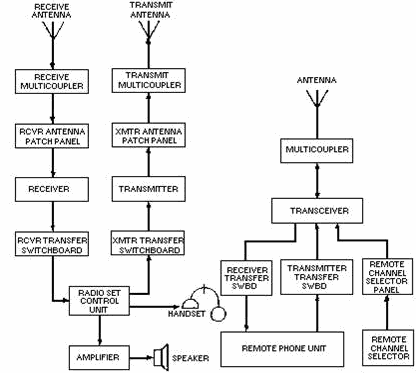
Figure 3-1. - Voice system.
HandSET
The handset converts acoustical energy (your voice) to electrical energy for use in modulating a radio transmitter. It also converts electrical energy to acoustical
energy for reproduction of a received signal. When the push-to-talk button is depressed
on the handset, the dc keying circuit to the transmitter is closed, placing the
transmitter on the air.
Handsets are normally connected to a radio set control unit.
Radio SET CONTROL UNIT
The radio set control unit shown in figure 3-2 provides a capability to remotely
control some radiophone transmitter functions and the receiver output. Some of the
controls are used for turning the transmitter on and off. Others are used for voice
modulating the transmission (or keying when CW operation is desired). You can even
control the audio output level of the receiver and silence the receiver when transmitting.
3-2
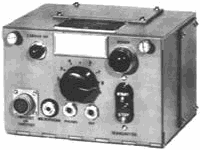
Figure 3-2. - Radio set control unit.
Under standard operating conditions up to four of these units can be used in
parallel with a single transmitter and receiver group to provide additional operating
positions. This setup is often found aboard ship where a transmitter and/or receiver
is controlled and operated from several locations such as the bridge or the combat
information center.
Transfer SwitchBOARDS
A transmitter transfer switchboard provides the capability to transfer remote
control station functions and signals to transmitters. Figure 3-3 is a representative
transfer switchboard that provides the capability for selectively transferring any
one, or all, of ten remote control station functions and signals to any one of six
transmitters. The cabinet has ten rotary switches arranged in two vertical rows
of five each. Each switch has eight positions. The circuitry is arranged so that
you cannot parallel transmitter control circuits; that is, you cannot connect more
than one transmitter to any remote control location.
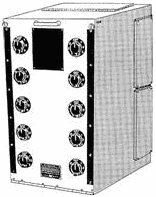
Figure 3-3. - Transmitter transfer switchboard.
Each switch operating knob corresponds to a remote control station. Each switch
position (1 through 6) corresponds to a transmitter. One switch position, X, provides
for transfer of all circuits to additional
3-3
transmitter transfer switchboards when more than six transmitters are installed
in the system. When the rotary switch is placed in the ofF position the remote control
station is removed from the system.
Let's look at an example of one transfer switchboard application. When remote
control station number two is to have control of transmitter number three, the switch
knob designated number two is rotated until its pointer indicates position three
on its dial plate.
The receiver transfer switchboard permits the operator to transfer the audio
output from a receiver to a remote control station audio circuit. a representative
receiver transfer switchboard is shown in figure 3- 4. This switchboard contains
ten seven-position switches. Each switch is connected to a remote control station,
and each switch position (one through five) is connected to a receiver.
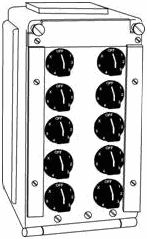
Figure 3-4. - Receiver transfer switchboard.
The X position on each switch allows transfer of circuits to additional switchboards
just like with the transmitter transfer switchboard.
Q1. What are the basic functions of a handset?
Q2. What capability does a transmitter transfer switchboard provide?
Q3. What function does a receiver transfer switchboard perform?
Transmitters
You learned earlier that transmitters may be simple with low power (milliwatts)
capabilities. These may be used to send voice messages a short distance. You may
also use highly sophisticated units that use thousands (even millions) of watts
of power to send many channels of data (for example voice, teletypewriter, television,
telemetry) simultaneously over long distances. Let's look at a complete transmitter
set.
3-4
Radio Transmitting Set
The applications, configurations, and components you will become familiar with
here are typical of most general purpose transmitter systems used in the Navy. a
specific transmitter is used only for ease of illustration and example.
We will be discussing a 1,000 watt, single-sideband radio transmitting set that
is available to the Navy in any one of four setups. The normal configuration has
a transmitter capable of voice, continuous wave, and radio teletypewriter transmissions
in the 2- to 30-megahertz frequency range. Exact spacing and number of channels
available within the frequency spectrum, modes of operation, and frequency range
depend on the model of equipment and how it is configured for use. Stack or rack
mounting is used in a ship or shore permanent installation with accessory equipment
(for example an RF amplifier, coupler control unit, or power supply) to form a complete
communications system. One of three different three- phase primary power sources
can be used (depending on whether the transmitter is land, air, or shore based)
to provide operating power to the set. Combinations available are 115 volts, 400
hertz; or 208/440 volts, 60 hertz.
General Description
Figure 3-5 shows the major units of this set. They are the radio transmitter,
the radio frequency amplifier, the power supply, and the electrical equipment shock
mount base. An antenna coupler group (consisting of a coupler and coupler control
unit) is normally used to match the impedance of the system to a 50-ohm transmission
line. If you want to operate with any 50-ohm antenna system, terminating connections
are available.
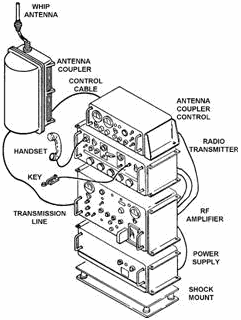
Figure 3-5. - Radio transmitting set.
3-5
The transmitter unit provides an upper sideband (usb), lower sideband (lsb),
independent sideband (isb), CW, FSK, or compatible AM signal. The output of the
transmitter has enough power to drive the radio frequency amplifier.
Depending on the model, the transmitter tunes across the frequency range in 100-
or 500-hertz increments. Digital circuitry is used to accomplish this process. Transmitter
outputs are also applied to the RF amplifier to automatically tune it to the correct
frequency. We will go through a detailed breakdown of the transmitter unit later
in this chapter.
Radio Frequency Amplifier. - The RF amplifier unit is a two-stage
linear power amplifier that produces an output of 1,000 watts with a nominal input
of 100 milliwatts. Nineteen frequency bands are used to cover the operating frequency
range. The operating band is automatically selected by digital coding generated
by the transmitter. The code controls two motor-driven band switch assemblies. Automatic
control circuits protect the unit against overload and compensate for variations
in system gain, mode of operation, and loading.
All low voltages required for operation (except two of the relay control voltages)
are internally produced. The high voltages required in the amplifier stages are
produced by the associated power supply (when using 60 hertz primary power) or the
optional internally mounted power supply (when using 400 hertz primary power).
Let's take a look at figure 3-6 to see all the operating controls and indicators
located on the front panel. Some controls are used only for initial setup and are
protected by a hinged access cover. All connections are made at the rear of the
case. The amplifiers and the associated interstage broadband transformer assemblies
are cooled by forced ventilation. Cooling air is drawn through a filter on the front
panel and exhausted through a port on the rear of the case. You should always take
particular care to clean or replace any filter in electronic equipment as a regular
part of your preventive maintenance program.
3-6
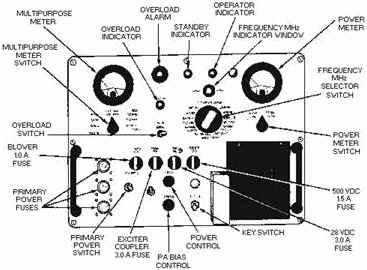
Figure 3-6. - Rf amplifier unit.
Power SUPPLIES. - One power supply produces operating voltages
for the amplifier when operating from a 60-hertz power source. All components of
the power supply, except the power transformers, are mounted on a chassis and panel
assembly that is hinge-mounted to a metal case. The power transformers are constructed
as part of the case and there are no operating controls.
The other power supply produces operating voltages for the RF amplifier when
a 400-hertz, three- phase, 115-volt primary power source is used.
Antenna COUPLER GROUP. - The antenna coupler group is an automatic
antenna tuning system. However, the equipment design includes provisions for manual
or semiautomatic tuning. This makes the system adaptable for use with other radio
transmitters. The manual tuning capability is useful when a failure occurs in the
automatic tuning circuitry. Tuning can also be accomplished without the use of RF
power (SILENT TUNING). This method is useful in installations where radio silence
must be maintained except for brief transmission periods.
The antenna coupler matches the impedance of a 15-, 25-, 28-, or 35-foot whip
antenna to a 50-ohm transmission line at any frequency in the 2- to 30-megahertz
range. Control signals from the associated antenna coupler control unit automatically
tune the matching network in less than five seconds. During manual and silent operation,
tuning is accomplished by the operator with the controls mounted on the antenna
coupler control unit. a low power (not to exceed 250 watts) CW signal is required
for tuning. Once tuned, the coupler is capable of handling 1,000 watts peak envelope
power (pep).
The coupler is enclosed in an aluminum, airtight, pressurized case. Six mounting
feet enable the unit to be attached to the mast of a ship at the base of a whip
antenna. The coupler is pressurized with dry nitrogen to aid internal heat transfer
and to prevent corona and arcing. All components of the coupler are secured to a
chassis that is mounted to the case so that an air duct exists between the chassis
plate and the
3-7
case. An internal fan circulates the nitrogen over and through the heat-producing
elements and then through the air duct. While passing through the air duct, the
nitrogen loses its heat to the bottom of the case. This heat is then transferred
by convection through fins on the bottom of the case and by conduction through the
mounting feet.
Figure 3-7 shows the antenna coupler control unit. This unit provides the power
and control signals required to tune the coupler. Control signals are either automatically
produced by the coupler control when a tune cycle is initiated or manually produced
with the front panel controls.
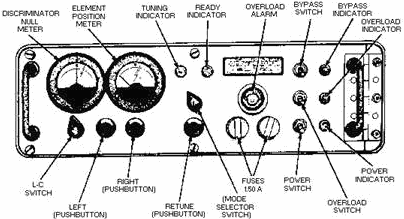
Figure 3-7. - Antenna coupler control unit.
All dc operating voltages are produced from a 115-volt, 48- to 63- or 350- to
450-hertz, single-phase primary power source. Meter and protection circuits are used to give you complete control of the coupler from the remotely positioned coupler
control unit.
Q4. If the RF amplifier discussed has an 80 milliwatt input, what
would be the maximum output?
Q5. What are the tuning modes for the coupler group discussed?
Q6. What is the purpose of an antenna coupler?
Q7. Why is the coupler pressurized with nitrogen?
Radio Transmitter. - Figure 3-8 shows the front panel of the
radio transmitter unit. The radio transmitter accepts audio or coded intelligence
and uses it to modulate one of 280,000 possible operating radio frequencies in the
2.0- to 29.999-megahertz frequency range. Tuning is accomplished digitally by means
of five control knobs and a switch located on the front panel. The transmitter has
a normal RF output level of at least 100 milliwatts and is designed to be used with
an associated RF power amplifier.
3-8
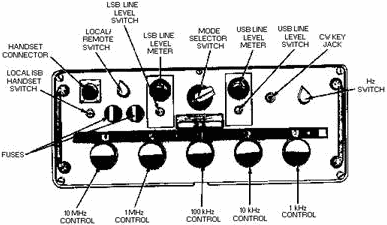
Figure 3-8. - Radio transmitter unit.
When the AM and SSB transmit modes of operation are used, the output from a handset
is applied to the transmitter. The voice signals are amplified and used to modulate
a 500-kilohertz local carrier that produces a 500-kilohertz IF. The resulting double
sideband signal is filtered in the AM mode, amplified, and converted by a triple-conversion
process to the desired RF operating frequency. The RF signal is amplified to a nominal
100 milliwatt level. In CW operation, the 500-kilohertz local carrier is inserted
directly into the IF amplifiers. The signal is further processed in the same manner
as the voice signals in the AM or SSB modes of operation. In FSK operation, the
loop current is converted to audio frequencies representing marks and spaces. These
audio signals are applied to the audio circuits of the transmitter. Thereafter,
these signals are processed in the same manner as the voice signals in AM or SSB
modes of operation. a typical radio transmitting set block diagram is shown in figure
3-9.
3-9
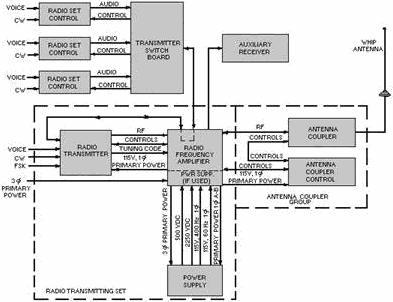
Figure 3-9. - Typical radio transmitting set block diagram.
RECEIVERS
The receiver we will discuss is a triple-conversion superheterodyne, tunable
from 2 to 30 megahertz. Triple conversion uses three IF frequencies to give better
adjacent-channel selectivity and greater image- frequency suppression. Figure 3-10
shows the front panel of this receiver where tuning is done digitally by five controls
and a switch. a display window directly above each control provides a digital readout
of the frequency setting. The displayed frequency can be changed in 1-kilohertz
increments. The front panel switch allows the operating frequency to be changed
in 100- or 500-hertz increments depending on the model. This will provide you with
280,000 discrete frequencies locked to a very accurate frequency standard. You can
continuously tune each 1,000-hertz increment by selecting the VERNIER position of
the hertz switch. When using the vernier, the full accuracy of the frequency standard
is sacrificed. The receiver demodulates and provides audio outputs for the LSB,
USB, IsB, AM, CW, and FSK types of received signals.
3-10
|

















